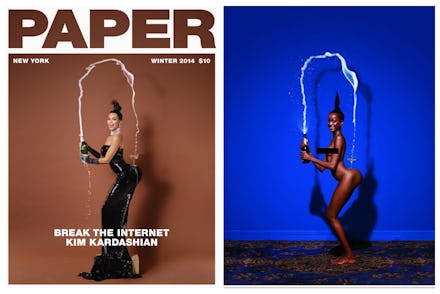The Big Problem With Kim Kardashian's Butt Photos Nobody Is Talking About

Kim Kardashian strikes again.
The infamous reality star "broke the Internet" — or at least, got a lot of people on the Internet talking — this week by flaunting her backside for the cover of Paper magazine and then doubling down hours later with additional full-frontal shots. But the fanatic reaction to her curves reveals a much deeper issue regarding how women's bodies are viewed in public forums, especially given the way female curves have been historically treated in the media and the art world.
The reality star's photos were taken by a white photographer with a history of playing up racial tropes about black women's bodies. Kardashian's willingness to go along with the shoot — and the relative ignorance of the majority who have commented on it — reflects a disturbing lack of awareness when it comes to the exploitation of black bodies, specifically black women.
Reportedly, Kardashian did the shoot without getting paid because she wanted to work with renowned photographer Jean-Paul Goude. The cover itself is a recreation of Goude's 1976 photo "Carolina Beaumont" otherwise known as the "Champagne Incident." The photo (NSFW) shows a naked, smiling black woman standing in front of a blue wall, balancing a champagne glass on her butt in a half-squatting and arguably subservient position.
The 1976 photo was part of a larger photo book titled Jungle Fever, featuring black women in a series of poses that fetishized and even animalized their bodies.
Goude's obsession with black women's bodies has been widely noted as troublesome for how his work has perpetuated the dehumanizing logic that black women's bodies are objects to be displayed or even violated by white men. In one part of Jungle Fever, as noted by author Janell Hobson, Goude compares the backsides of black women to those of "race horses."
And when held alongside the stories of other black women dating back to slavery, this treatment becomes all the more problematic. Indeed, the "Carolina Beaumont" and the nude shots from Kardashian have strong echoes of the "Hottentot Venus" — real name Saartjie Baartman — of the late 18th century.
Baartman was a glorified walking art exhibition, exhibited as a public sideshow for white audiences across Europe, enduring humiliations and sexual abuse during the process. The draw? Her curves. After passing away at age 25 to venereal disease, Baartman was dissected and her body was preserved so that she could remain on display for decades. She only received a proper burial 187 years after her death.
Until then, she remained on a pedestal. Decades later, the parallels between that pedestal and the one Kardashian has been placed on are hard to ignore.
That unfortunate history factors into how black women's curves have long been regarded in popular culture. Adding to this is a pernicious double standard: How would the reaction have been different if the subject of the photo had been a darker-skinned entertainer? Recently, some black female celebrities have dared to own their agency and sexuality by proudly displaying their bodies on their terms. In these cases, the women endured a heightened backlash rooted in misogyny and racism, reactions that contrast tellingly with the widespread curiosity and amazement that has greeted Kardashian's photos.
Notably, when Rihanna posed topless for Lui magazine in April, she posted the pictures on Instagram and, as expected, had her account deleted for nudity. But the public harshly criticized her for baring her breasts in such a way. Meanwhile, Scout Willis walked topless through Manhattan and was rewarded with neutral and even positive media attention for her self-described protest.
Similarly, during the summer, Nicki Minaj released the cover for her hit single "Anaconda," in which she squats in front of a camera wearing nothing but a sports bra, Nike pumps and a thong. The bulk of the reaction reviled Minaj for displaying her derriere in such a way, with headlines accusing her of going "too far," while a bevy of people on social media labeled her a "fat whore." By comparison, most stories about Kardashian's photo shoot focus on the artistic process or the fact that she decided to bare all.
From how the Paper magazine photos were conceived, to how the public has received them, there's an unmistakable racial undercurrent that the majority of Americans have completely missed with Kardashian's photos. This is not about anyone breaking the Internet. This is about a longstanding trend in how artists and the general public regard and treat black women's curves.
Ultimately, this is why it's so important to know your history, so that pop culture does not purposefully — or inadvertently — perpetuate this double standard of denigration.